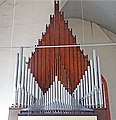Free pipe prospectus

Freipfeifenprospekt is a term from the organ building sector for a type of organ that was fully developed in the 1950s , in which the organ pipes are not surrounded by a case or covered by components, but stand free.
history
In organ building it is common to give the work a decorative case, the so-called prospectus , which on the one hand reflects the value of the instrument and on the other hand guarantees a certain protection of the instrument. The structure of the entire case also often reflected the arrangement of the individual parts of an instrument. In addition, the sound radiation played a calculated role in the past epochs.
In England in the 1840s a protective cover and a solidly crafted housing were dispensed with for cost reasons. Only a free, two-dimensional front side was designed, which was given a slight structure with wooden elements. These design elements also disappeared more and more and a design in towers and fields, grouped with pure show pipes, became the standard form of the organ in Victorian England. This visual influence increasingly shaped the organ building of the rest of Europe. There, at the end of the 19th century, the traditional tradition was broken. There, too, the housing idea faded into the background.
From the 1950s onwards, a possible structure was completely abandoned and a two-dimensional pipe front was placed in the foreground as a free pipe prospect according to symmetrical principles, which were sometimes given the mockery of garden fence prospectuses . These sometimes very bizarre free pipe prospectuses were often designed by the architect of the church and no longer by the commissioned organ builder. The visual design was finally detached from the inner workings of the instrument. Therefore, due to technical possibilities, the sound integration of the organ front was sometimes no longer possible. Silent brochures were created that only served the purpose of optics. On the other hand, free pipe brochures have also been created that reflect the mix of pipe materials (wood, copper) of the inner workings of an instrument on the outside. Sometimes it was possible to achieve a real stage-like design of the organ loft, which shows the space required by the organ on the loft area and increases it with the inclusion of the parapet area.
With the return to traditional organ building, the free pipe prospect is now less common. Sometimes it is still used in a visually very modern and timeless organ design.
A special form of the free pipe prospectus was developed by the Klais company from the 1930s. In contrast to conventional free pipe prospectuses, a pipe facade is completely dispensed with and the spatial arrangement of all pipes of the organ on its windchest is used as a design element. The smallest registers are often in the first row, while the size increases towards the back. A common design feature are bouquets of tongues, mostly made of flamed copper , which sprout like fountains from behind other rows of pipes. In this way, a very three-dimensional impression of the room is created, which shows the entire inner workings of the organ. Other companies that occasionally built organs with such a prospectus were Anton Feith ( Paderborn ), Hugo Mayer ( Heusweiler ) and Michael Weise ( Plattling ). Impressive representatives of this type of brochure can be found in the Herz-Jesu-Kirche Ludwigshafen and in the Frankfurt Cathedral .
Examples (selection)
Franz Liszt Music Academy in Budapest , 1907
St. Peter and Paul in Lindenberg im Allgäu , 1934
Sacred Heart Church in Regensburg , 1936
Herz-Jesu-Kirche in Munich , 2004
Marienkirche in Neubrandenburg , 2017
Special form of the free pipe prospectus on the Mayer organ in Maybach
literature
- Hermann Fischer , Theodor Wohnhaas : On the aesthetics of the free pipe prospectuses . In: Aspects of Organ Movement . Merseburger Berlin, Kassel 1995, p. 183-218 .
Web links
- Roland Eberlein : A little history of the organ. II. The development of the external design of the organ. 7. The free pipe prospectus. In: Website of the Walcker Foundation. Retrieved February 23, 2019 .











